| THIS WEEK'S ARTICLES |
| The Market Message |
| Major Stock Indexes are Trying to Stabilize |
| by John Murphy |
Major U.S. stock indexes continue to probe for a short-term bottom. The daily bars in Chart 1 show the S&P 500 regaining some lost ground over the last two weeks after falling to the lowest level in three years. But there's still a lot of overhead resistance to deal with. The SPX remains well below its red 200-day average. And its blue 50-day average has just slipped below its red 200-day line. In addition, the flat red trendlines overlaid on the price bars show the SPX meeting some selling at its 38% Fibonacci retracement line. That's usually the first line of resistance after a market selloff. The 14-day RSI line in the upper box also remains below potential resistance at its midpoint line at 50. Longer-range charts also remain a big concern.
When studying major market trends, longer-range charts are usually more important than daily charts. That's because the longer-range charts are better at determining the major direction of stock prices. And right now those longer-range charts aren't very encouraging. Chart 2 plots a weekly chart of the S&P 500 over the last six years. There's some good and bad news on the chart. The 14-week RSI line in the upper box is deeply oversold. In addition, the SPX has managed to climb back above broken support formed near the end of 2018 (green trendline). While that's mildly encouraging, it's not enough to restore the potential technical damage done during March to the market's long-term uptrend. In addition, its weekly MACD lines (middle box) remain in a steep downtrend. And the blue circle shows its 10-week average falling below its red 40-week line for the first time in more than a year. All of which suggests there's a lot more healing that needs to be done for stocks to regain upward momentum.
Chart 1
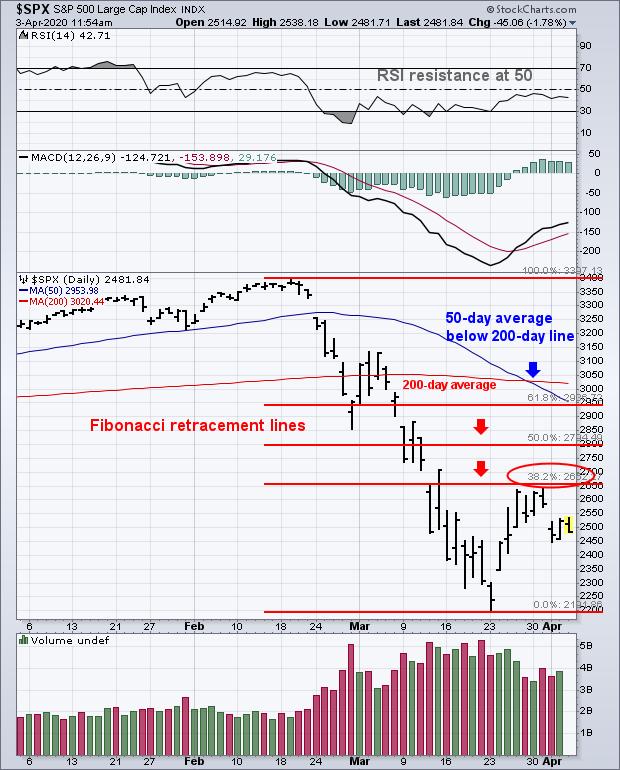
Chart 2

Editor's Note: This is an excerpt of an article that was originally published in John Murphy's Market Message on Friday, April 3rd at 11:15am ET. Click here to read the full article, which includes Chart 3 and an analysis of the SPX monthly chart.
|
| READ ONLINE → |
|
|
|
| Art's Charts |
| Elevators, Oversold Bounces and Long Recoveries |
| by Arthur Hill |
 The S&P 500 went from a historic decline to a historic bounce to an above average drop. This key benchmark fell 33.9% in 23 days, surged 17.55% in three days and then dropped 5.25% the last four days. In fact, the index has experienced nine swings of five percent or more since February 19th. Tis enough to make the Coney Island Cyclone look tame. The S&P 500 went from a historic decline to a historic bounce to an above average drop. This key benchmark fell 33.9% in 23 days, surged 17.55% in three days and then dropped 5.25% the last four days. In fact, the index has experienced nine swings of five percent or more since February 19th. Tis enough to make the Coney Island Cyclone look tame.
Even though the S&P 500 is making a lot of history, it is not making much headway as the index did not even come close to its falling 200-day SMA on the oversold bounce. Clearly, the long-term trend remains down. In case you were wondering, it would take a 51.4% gain to get back to the February highs.
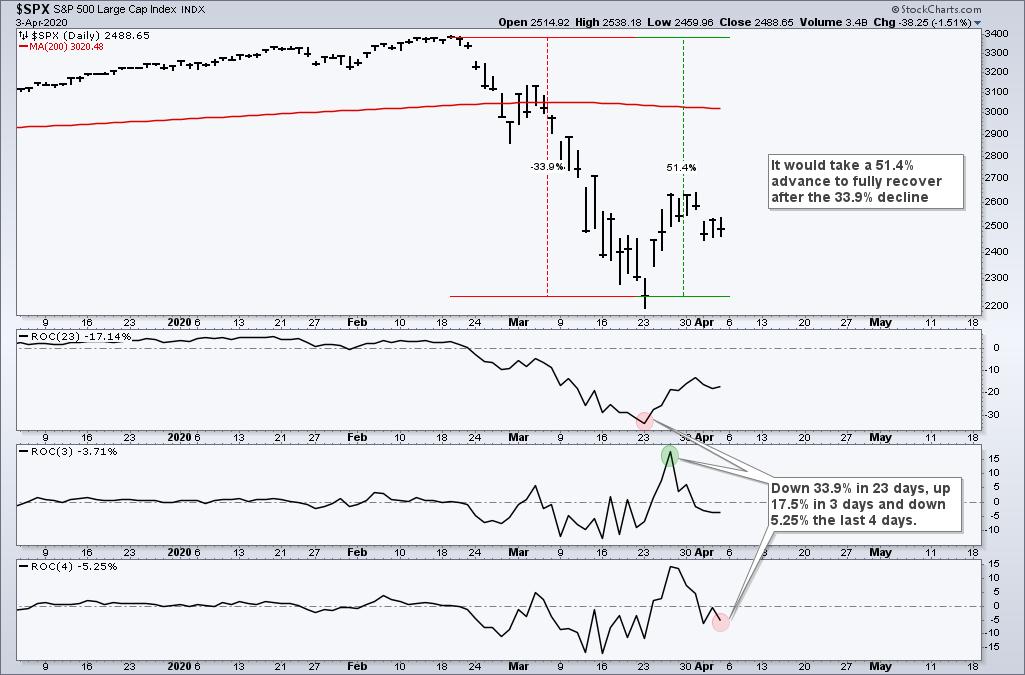
The deeper the decline, the bigger the advance needed to get back to break even. For example, a decline from 100 to 50 would be 50%. It would then take a 100% advance to get back to 100. With stocks often taking the elevator down and the stairs up, getting back to break even often takes a lot more time.
The next chart shows the round trip from October 2007 to August 2012 taking 253 weeks, which is around 59 months and almost 5 years. The S&P 500 fell 56% in 73 weeks and then took another 180 weeks to get it all back. It took more than twice as long to fully recover.
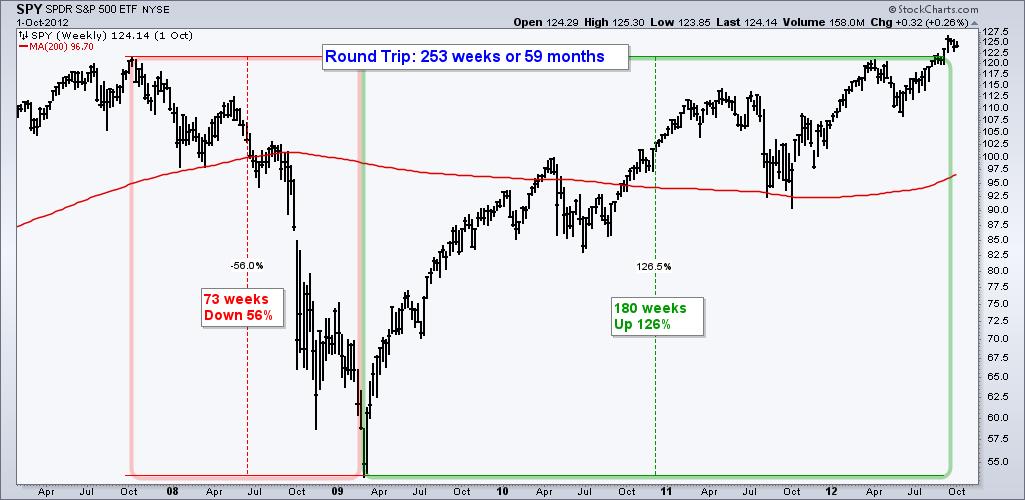
Not all bear markets are the same, but we also saw something similar between 2000 and 2007. There was also a ~50% decline in between and the recovery took twice as long as the decline.
I do not know how long this bear market will last or how deep it will go, but the evidence is currently bearish and investors should plan accordingly. At TrendInvestorPro.com, we take a weight-of-the-evidence approach to broad market timing and will continue to monitor our index and sector breadth models, which turned bearish at the end of February. In addition, the following reports were issued this past week:
- Putting the All-Weather Portfolio through the Wringer
- An Industry ETF and Stocks with Secular Growth Prospects
- Don't Fall for Red Herrings during a Bear Market
Click here to take your analysis process to the next level!
----------------------------------
|
| READ ONLINE → |
|
|
|
| The Canadian Technician |
| Bubblin' Crude |
| by Greg Schnell |
It has been a wild ride for those on the crude oil train this week. It's never good when your stocks are riding pandemic viruses, tweet storms, kingdoms, autocratic leaders and democracies trying to impose volume limits. While crude oil closed up 50% off the lows within a week, it was hardly one for the people of free markets.
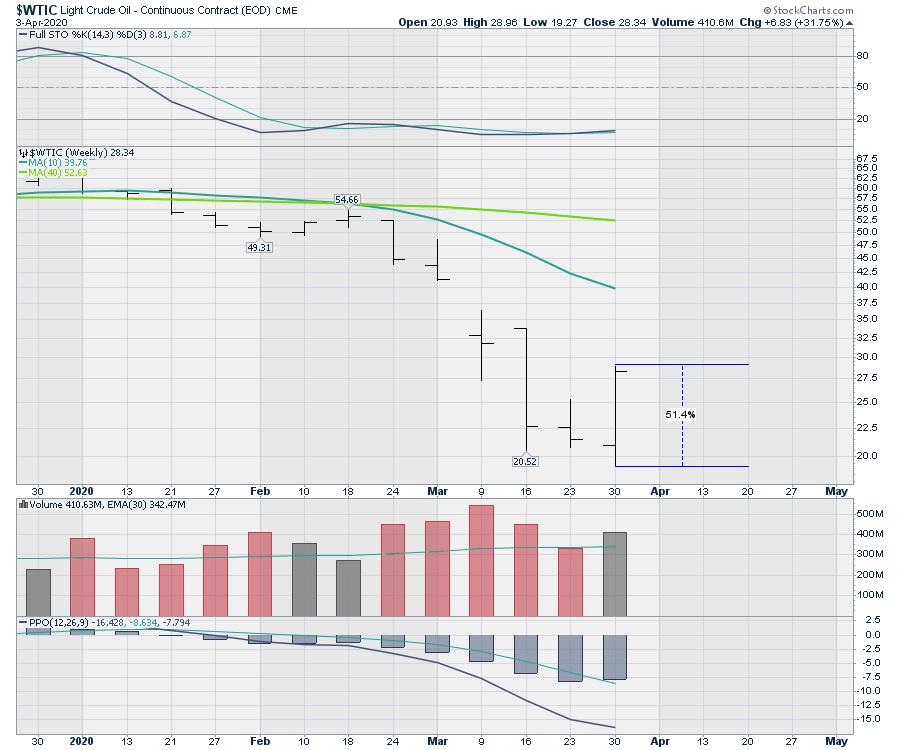
With the pandemic wiping out demand, we are in a new world. If oil consumption is going to be restrained due to people staying home and planes not flying, the world will quickly run out of storage.
Under this new reality, the principles of free markets are under pressure. Even with new production limits, it will take a long time to not only reduce production, but to reduce the number of barrels in storage worldwide. So, on a day with crude oil up big, many oil names fell. While the global production agreement may be coming soon, we still will need to curtail the volumes.
The biggest thing is that the downturn is global. This oil issue has to be managed from Nigeria, Iran, Iraq, Kuwait, Australia, Scotland, Norway, Canada, USA, Russia, Saudi Arabia and many other countries.
While crude oil was up 50% on the week, the exploration and production ETF was only up 8.8%.
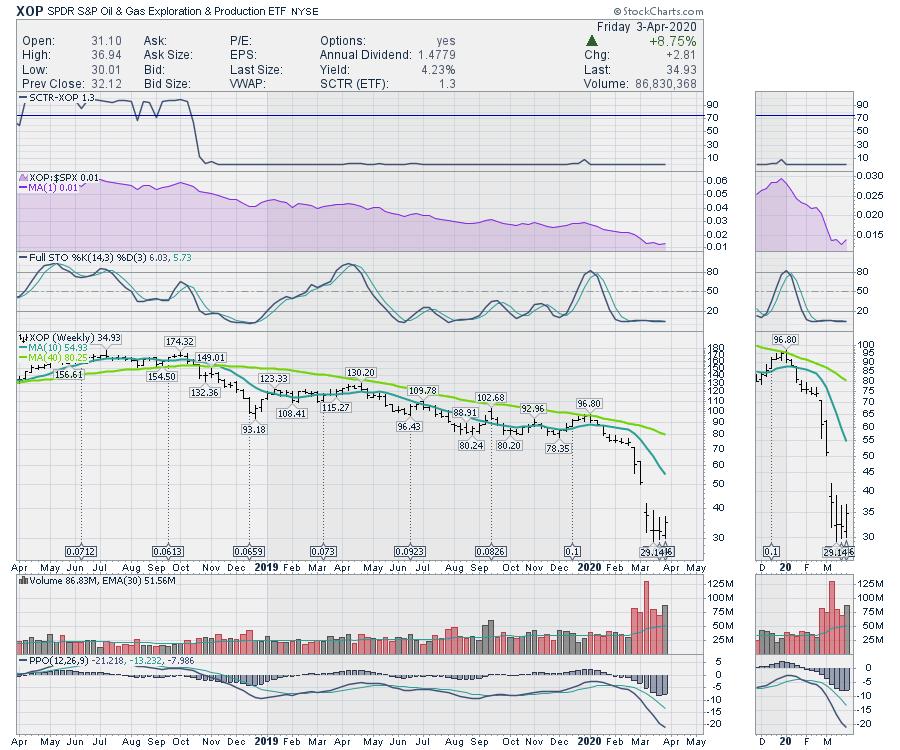
The price of oil, the volume of oil and who cuts is going to take a little time. After that, low prices stop wells from pumping. Another piece will be bankruptcies in non-state owned companies globally. The last thing is the ongoing decline rates of the reservoir. If no new wells are drilled for a significant period of time, this too shall pass.
I don't know if the lows for the price of oil are in, but there are a lot of reasons to expect the advance a little farther off in the distance. Again, one problem is the overproduction. The second problem is reflating the demand. Care will be required to build some normalcy into the industry. Lastly, oil is a significant source of revenue for many third-world countries. If this does not get repaired sooner than later, this can also cause social unrest, which would be an unwelcome and unhelpful side effect of the COVID-19 pandemic.
Watch oil and oil companies closely. We'll need to get things repaired quickly to restart the global economy.
|
| READ ONLINE → |
|
|
|
| The Traders Journal |
| Jesse Says "The Only Way You Get A Real Education..." |
| by Gatis Roze |

When I was a young man, there was a goofy comedy film called "The Gumball Rally" about a group of cross-country lead-footed auto racers. In an opening sequence, the character racing in his Alfa Romeo sports car jumps into the driver's seat, quickly rips the rear view mirror from its mounts and loudly proclaims "first rule of Italian road racing...what's behind you doesn't matter!"
Now unless you want your investing to be equally comedic and goofy, this proclamation does not apply to you. The opposite, however, does apply. In our book Tensile Trading: The 10 Essential Stages of Stock Market Mastery, we titled the tenth stage "Revisit, Retune, Refine" and the chapter opens with a famous quote:
"The only way you get a real education in the market is to invest cash, track your trade and study your mistakes."
These prophetic words of the great Jesse Livermore are particularly relevant today.
During difficult quarantined times such as these, it's important to remember that you are playing the long game. It's long term investing that counts. Academic research tells us that the human mind tends to give more importance and weight to a single bad event than to a half-dozen successes. Remember to factor in the reality that 90% of the time, news is over-exaggerated and the markets response is likewise over-exaggerated. Clearly, what's behind you does matter. In fact, it's the very basis of your evolution from an average investor into a consistently successful investor.
Being sequestered right now is the ideal time to review your investment decision making, evaluate your execution, revisit your methodology and reflect on your "Investor Self" with brutal self-honesty. In our book, we describe this process as the Four R's of investing.
- Reshape your learning curve
- Realign your thinking
- Reprogram your discipline
- Refine your trading skills
The payoff for you is huge. These four steps can keep you action-oriented and help motivate you to move forward confidently with an improved skill set that will pay dividends for all the years ahead. To that end, here are links to three previous blogs that might speak to you today.
The Albert Einstein Approach to Stock Market Investing
How the Markets Have Changed Me Over the Past 25 Years: Part I
The 10 Key Investing Lessons From Two Decades Of Teaching (1999 - 2019)
Trade well; trade with discipline!
- Gatis Roze, MBA, CMT
StockMarketMastery.com
|
| READ ONLINE → |
|
|
|
| DecisionPoint |
| DecisionPoint Short-Term Indicators Are Nailing It! |
| by Erin Swenlin |
Today's ChartWatchers article is an updated excerpt from the DecisionPoint Alert Report for subscribers:
I pointed out to my subscribers on Thursday that, with all of the volatility, our short-term indicators seem to be more on point than usual. Below, I've included three indicator charts that I think you will find interesting.
Overhead resistance continues to prove too much for the market. After reaching a strong "zone of resistance," the 20-EMA and the Fibonacci Retracement line, price gapped down. Total volume is moving lower, but is still well-above the annual average. It is bearish to see a decline in volume concurrent with a rising market. The Bollinger Bands on the VIX are beginning to contract, meaning that readings will be hitting the top band soon. That is an overbought condition in a bear market. We will want to watch this carefully.
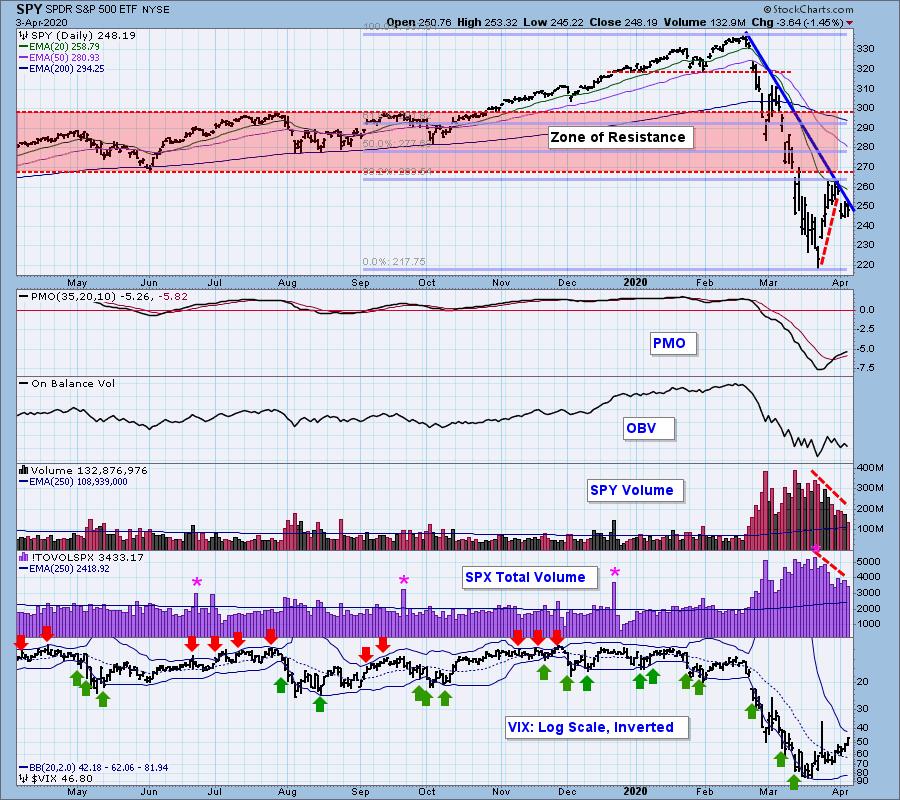
Climactic Market Indicators: Today's ChartWatchers headline implies that, so far, our short-term breadth indicators have been quite helpful. Indeed, they have been. Declining tops in negative divergences with rising tops on price are coming right before downturns. We also saw a positive divergence -- while price was falling, there were rising bottoms on the breadth indicators, which suggested less negativity below the surface. We may be starting to see a contraction on negative readings on the Net A-D bars, which previously was an indicator that a short-term bottom was coming. I need to see a few more days of bearish readings contracting to really identify if the market will find a short-term bottom again. Currently, the decline in positive breadth tells me we aren't out of the woods just yet. The VIX is rising on the inverted scale, but the upper Bollinger Band is close by 42.18.
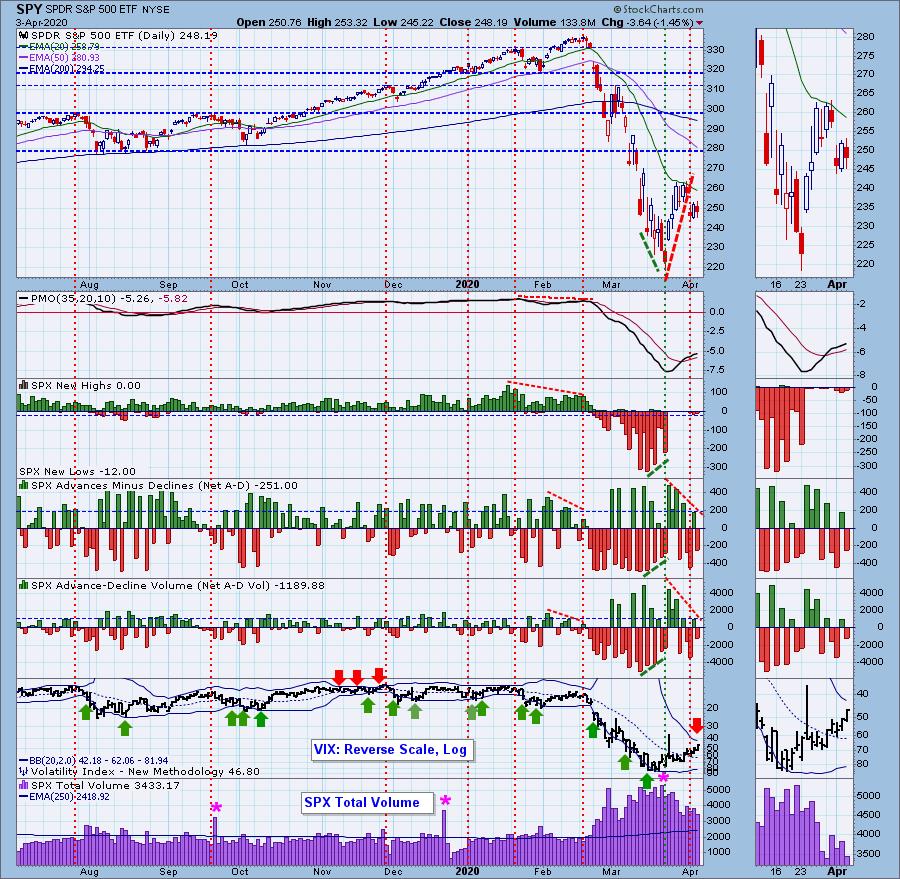

As investors, we want to accomplish two basic things: (1) Determine the trend and condition of the market, and (2) select stocks that will ride that tide. The DecisionPoint Alert helps with the first step, and DecisionPoint Diamonds helps with the second. Go to DecisionPoint.com and SUBSCRIBE TODAY!
Short-Term Market Indicators: The ST trend is UP and the market condition is NEUTRAL based upon the Swenlin Trading Oscillator (STO) readings. You may question readings being considered "neutral," as the -200 level tends to identify as oversold under normal market conditions. Ah! Key word "normal". We are in a bear market and it won't be unusual to see readings stretching back to the -700 level. Notice how all of these indicators started moving lower despite recent gains for the SPY. Again, very timely turnaround on the the STOs.
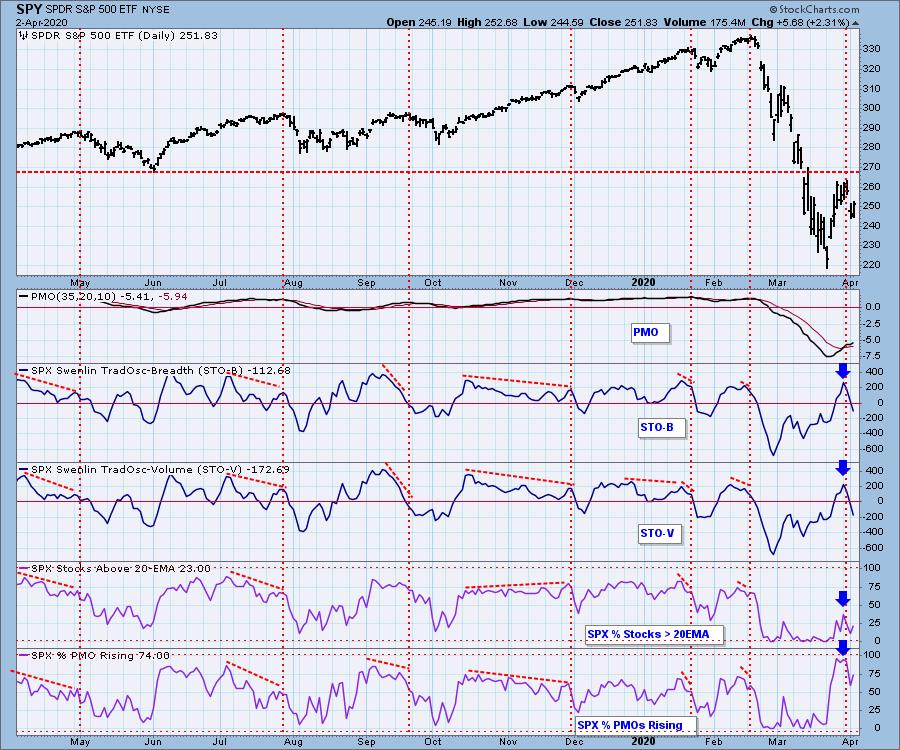
CONCLUSION: Our DecisionPoint Alert subscribers have had the opportunity to see and be on top of all of these indicators throughout this bear market, and they have been nailing tops and bottoms. Given the current condition of these indicators, I would look for another test of bear market lows very soon. When the Swenlin Trading Oscillators begin to turn back up, our readers will be the first to know!
Technical Analysis is a windsock, not a crystal ball.
Happy Charting! - Erin
Email: erin@decisionpoint.com

New dates have been released for The Money Show in Las Vegas! Erin Swenlin will still be presenting at the The MoneyShow Las Vegas August 16-18, 2020 at Bally's & Paris Resorts! You'll have an opportunity to meet Erin and discuss the latest DecisionPoint news and Diamond Scans. Claim your FREE pass here! You can watch online with this pass too!!
Helpful DecisionPoint Links (Can Be Found on DecisionPoint.com "Blogs & Links" Page)
Erin's PMO Scan
DecisionPoint Shared ChartList and DecisionPoint Chart Gallery
Trend Models
Price Momentum Oscillator (PMO)
On Balance Volume
Swenlin Trading Oscillators (STO-B and STO-V)
ITBM and ITVM
SCTR Ranking
|
| READ ONLINE → |
|
|
|
| ChartWatchers |
| Get Ready to be Shocked - To the Upside |
| by John Hopkins |
If there ever was a time to be worried about where the market could be headed, this is it. We've seen the weekly jobless claims go from a boring week-to-week reading of just over 200,000 all the way to now 6 million over the course of a month. We saw the government monthly non-farm payroll report go from adding a few hundred thousand jobs to a loss of 700,000 jobs in the blink of an eye. And, by next month, start thinking millions.
We've seen the world shut down. Restaurants, hotels, cruise ships shuttered. Air traffic falling 90%. Auto production lines stopped. Everyone hunkered down. And, worst of all, so many getting sick and many dying as we look for a cure. A horror show unfolding before our very eyes.
What else have we seen? We've seen the S&P lose almost 40% of its value in a flash, stunning almost everyone who was holding stocks long over the past month. We've seen more history making moves - both up and down - than any of us could ever imagined. All over the span of 30 days.
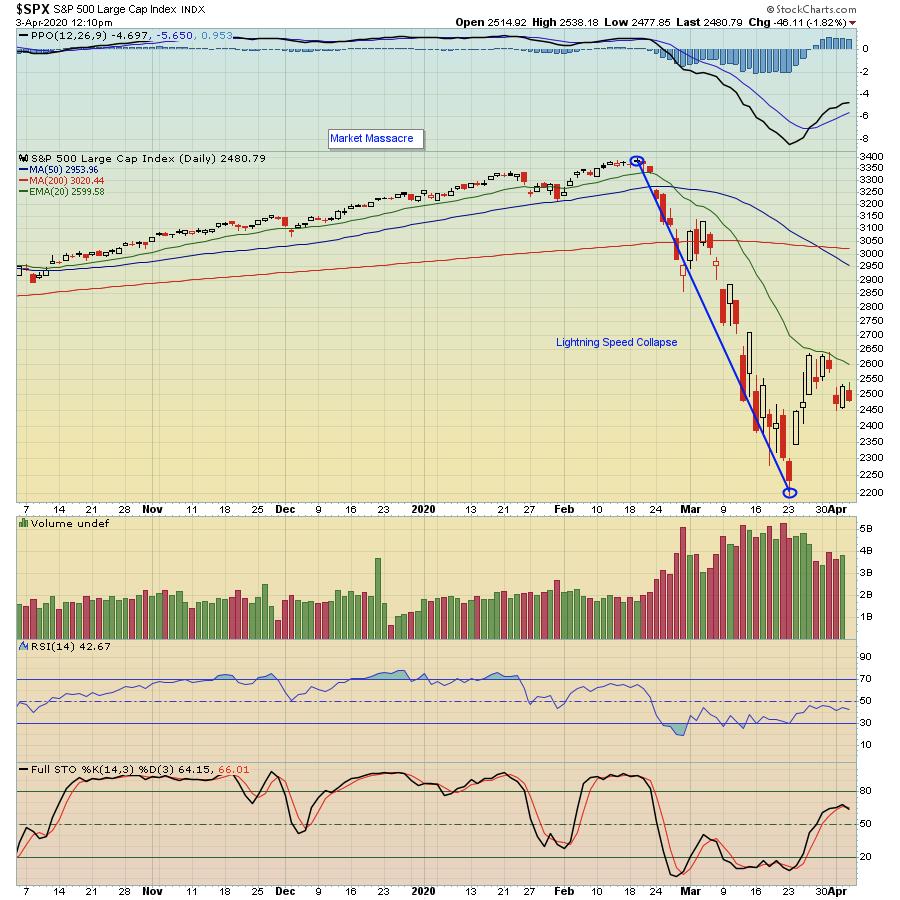
So, when you see a headline like you do in this article, you must be shaking your head, and it would be hard to blame you! Yet, in looking at everything that has been thrust upon us these past 30 days, there is light at the end of the tunnel, even if we do indeed revisit the most recent low of 2191 on the S&P.
Of course, no one can predict if and when an "ultimate" bottom will be hit, though that March 23 low could have done the trick. But, in looking at everything that has already taken place, examining those periods in history that came closest to this current pummeling, and considering the amount of fear that has enveloped the market, it's telling us that the worst of the worst may have already taken place.
What else has happened? Something also unseen in the past - the US government throwing everything it's got (and more) at the economy in an effort to keep the US financial structure afloat as we move through this diabolical virus. And, if round one and two don't do the trick, watch for rounds three and four. The Fed "all in" behind the economy shows the seriousness of the situation - and it is going to be attacked full force until things turn around.
Our Chief Market Strategist, Tom Bowley, conducted a webinar this past Friday which, I believe, puts everything in perspective. What has history shown us? What side of the buy/sell side is Wall Street on? What are signals, including the VIX and Put/Call ratio, telling us? What strategies might traders employ during these highly volatile times? How important is Accumulation/Distribution these days (hint: VERY!)? This is an all encompassing webinar, including how you can use both EarningsBeats.com and StockCharts.com tools to find high reward-to-risk trading candidates in the current market environment, and we would like EVERYONE who is looking for answers to have a copy of the recording. So, if you are NOT currently an EarningsBeats.com or EarningsBeats Digest member, just click on this link and fill out the EarningsBeats Digest form; we will make sure you get the recording before Monday's open. In the meantime, be safe.
At your service,
John Hopkins
EarningsBeats.com
|
| READ ONLINE → |
|
|
|
|
|
| MORE ARTICLES → |
|




 The S&P 500 went from a historic decline to a historic bounce to an above average drop. This key benchmark fell 33.9% in 23 days, surged 17.55% in three days and then dropped 5.25% the last four days. In fact, the index has experienced nine swings of five percent or more since February 19th. Tis enough to make the Coney Island Cyclone look tame.
The S&P 500 went from a historic decline to a historic bounce to an above average drop. This key benchmark fell 33.9% in 23 days, surged 17.55% in three days and then dropped 5.25% the last four days. In fact, the index has experienced nine swings of five percent or more since February 19th. Tis enough to make the Coney Island Cyclone look tame.


















